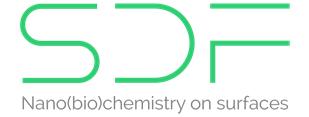
A network of self-assembled polystyrene beads was employed as a lithographic mask during covalent functionalization reactions on graphitic surfaces to create nanocorrals for confined molecular self-assembly studies. The beads were initially assembled into hexagonal arrays at the air-liquid interface and then transferred to the substrate surface. Subsequent electrochemical grafting reactions involving aryl diazonium molecules created covalently bound molecular units that were localized in the void space between the nanospheres. Removal of the bead template exposed hexagonally arranged circular nanocorrals separated by regions of chemisorbed molecules. Small molecule self-assembly was then investigated inside the resultant nanocorrals using scanning tunneling microscopy (STM) to highlight localized confinement effects. Overall, this work illustrates the utility of self-assembly principles to transcend length scale gaps in the development of hierarchically patterned molecular materials.
Self-Assembled Polystyrene Beads for Templated Covalent Functionalization of Graphitic Substrates using Diazonium Chemistry H. Van Gorp, P. Walke, A. M. Bragança, J. Greenwood, O. Ivasenko, B. Hirsch, and S. De Feyter ACS Applied Materials & Interfaces, http://dx.doi.org/10.1021/acs.jpcc.7b11717 Link to publisher
To enable comments sign up for a Disqus account and enter your Disqus shortname in the Articulate node settings.


